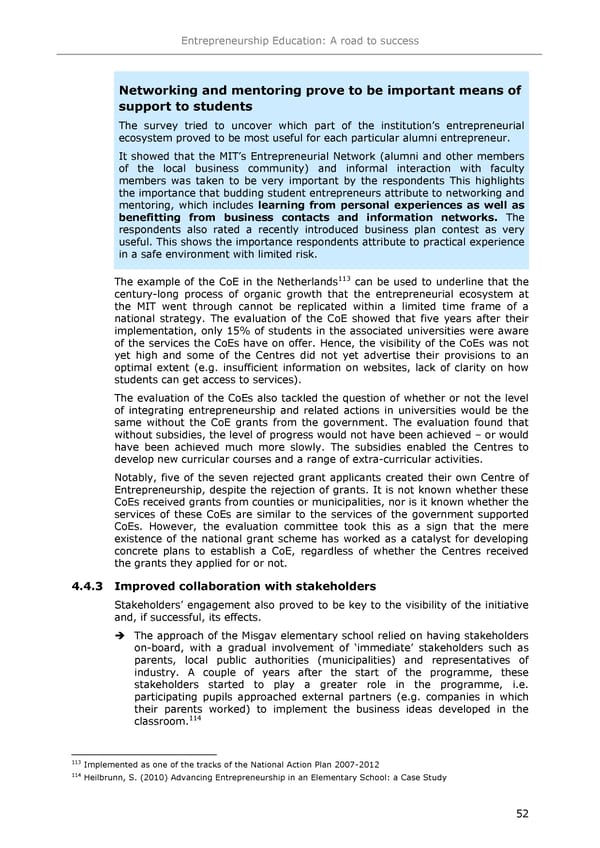Entrepreneurship Education: A road to success Networking and mentoring prove to be important means of support to students The survey tried to uncover which part of the institution9s entrepreneurial ecosystem proved to be most useful for each particular alumni entrepreneur. It showed that the MIT9s Entrepreneurial Network (alumni and other members of the local business community) and informal interaction with faculty members was taken to be very important by the respondents This highlights the importance that budding student entrepreneurs attribute to networking and mentoring, which includes learning from personal experiences as well as benefitting from business contacts and information networks. The respondents also rated a recently introduced business plan contest as very useful. This shows the importance respondents attribute to practical experience in a safe environment with limited risk. 113 The example of the CoE in the Netherlands can be used to underline that the century-long process of organic growth that the entrepreneurial ecosystem at the MIT went through cannot be replicated within a limited time frame of a national strategy. The evaluation of the CoE showed that five years after their implementation, only 15% of students in the associated universities were aware of the services the CoEs have on offer. Hence, the visibility of the CoEs was not yet high and some of the Centres did not yet advertise their provisions to an optimal extent (e.g. insufficient information on websites, lack of clarity on how students can get access to services). The evaluation of the CoEs also tackled the question of whether or not the level of integrating entrepreneurship and related actions in universities would be the same without the CoE grants from the government. The evaluation found that without subsidies, the level of progress would not have been achieved 3 or would have been achieved much more slowly. The subsidies enabled the Centres to develop new curricular courses and a range of extra-curricular activities. Notably, five of the seven rejected grant applicants created their own Centre of Entrepreneurship, despite the rejection of grants. It is not known whether these CoEs received grants from counties or municipalities, nor is it known whether the services of these CoEs are similar to the services of the government supported CoEs. However, the evaluation committee took this as a sign that the mere existence of the national grant scheme has worked as a catalyst for developing concrete plans to establish a CoE, regardless of whether the Centres received the grants they applied for or not. 4.4.3 Improved collaboration with stakeholders Stakeholders9 engagement also proved to be key to the visibility of the initiative and, if successful, its effects. The approach of the Misgav elementary school relied on having stakeholders on-board, with a gradual involvement of 8immediate9 stakeholders such as parents, local public authorities (municipalities) and representatives of industry. A couple of years after the start of the programme, these stakeholders started to play a greater role in the programme, i.e. participating pupils approached external partners (e.g. companies in which their parents worked) to implement the business ideas developed in the 114 classroom. 113 Implemented as one of the tracks of the National Action Plan 2007-2012 114 Heilbrunn, S. (2010) Advancing Entrepreneurship in an Elementary School: a Case Study 52
 Entrepreneurship Education Page 55 Page 57
Entrepreneurship Education Page 55 Page 57